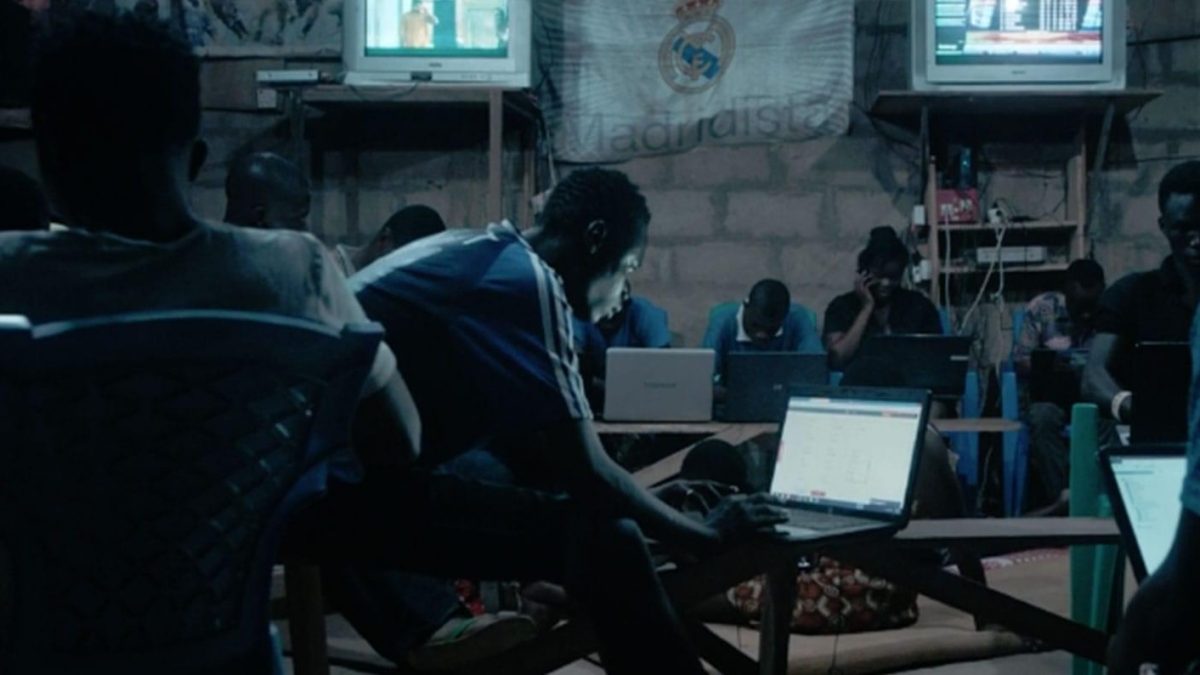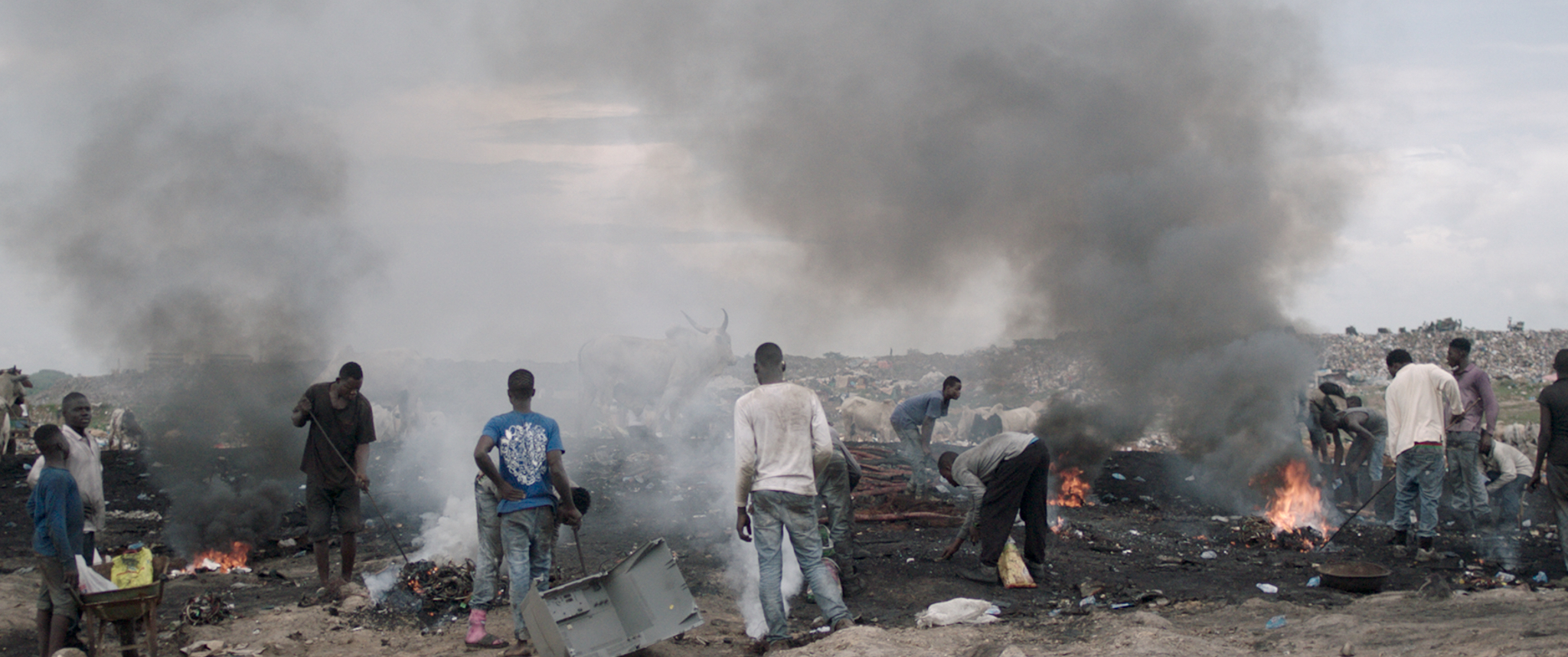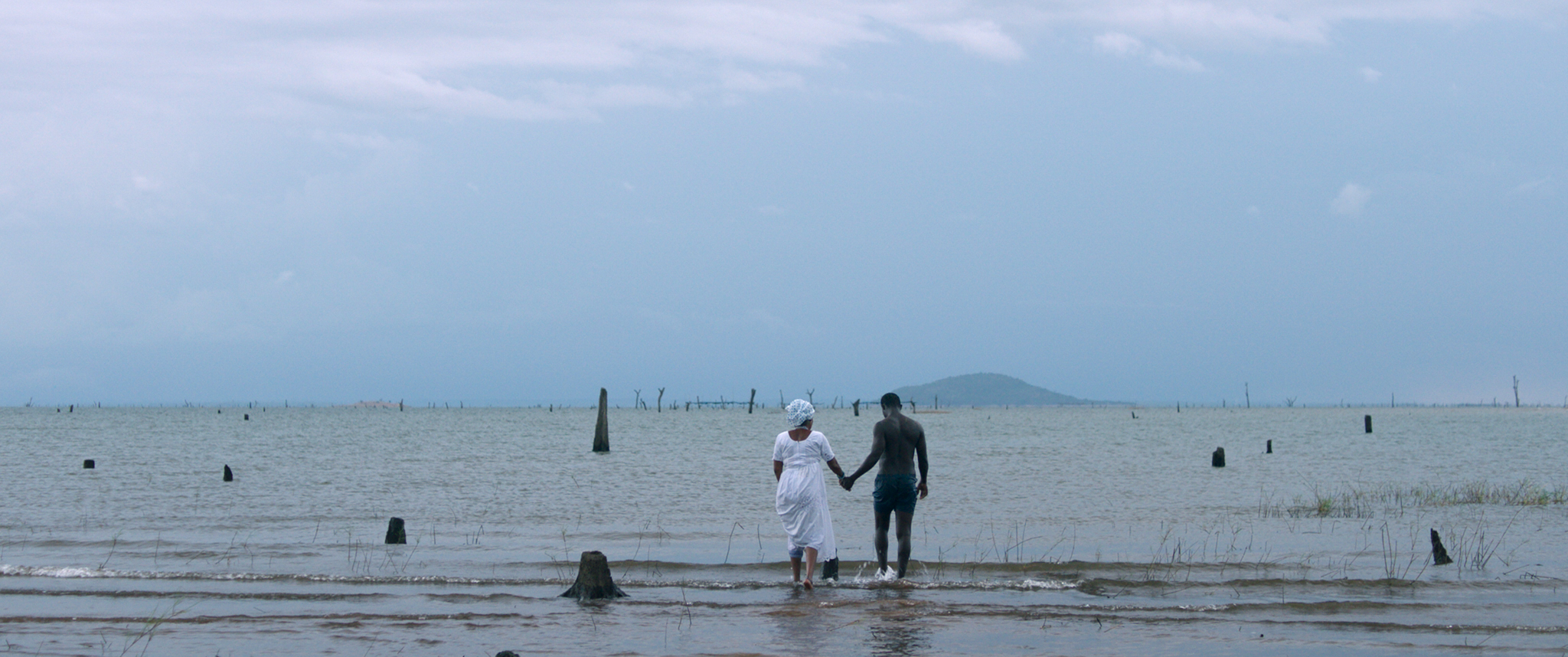The opening scene of Sakawa, a feature film by Belgian-Ghanaian filmmaker, Ben Asamoah, portrays a group of young men working in a darkened room, illuminated by the dim, blue-light of their laptop screens (see figure 1). In another early scene, we see another group of young men, and one woman, working at their laptops, this time by daylight (see the header figure above). These are ‘sakawa boys’, named after the form of cybercrime that they practice. The term sakawa is a Hausa word that means ‘putting inside’ or ‘how to make money’ and refers to a combination of internet fraud, traditionalist African ritual practice, and gender performance.[1] Sakawa boys believe that practicing traditionalist rituals will allow them to be more successful in their attempts to defraud their victims: namely white, middle-aged European and North American men. Led by wayward men or spiritual priests, sakawa boys are rumoured members of sakawa cults whose initiation rites are said “to involve socially grotesque acts such as sleeping in coffins, public nudity, refraining from bathing, ritual murder, and cannibalism.”[2] These rumours are disputed, and little to no evidence exists for their taking place. Nonetheless, sakawa continues to pervade the popular imagination as evidence of the moral decline of Ghanaian youth, and of the persistence of anachronistic belief systems out of step with an increasingly digital African societies. In his representation of sakawa, Asamoah shows sakawa boys carrying out rituals, constructing fictitious identities, and speaking with potential victims or ‘clients’ online. “I’m also single with no kids seriously looking for a honest, caring and trusted man to spend the rest of my life with,” writes ones sakawa boy. “I have missing your cock swallow it ease,” writes another. Asamoah also shows the interactions between sakawa boys about the relative success or failure of their labour, and about the material conditions under which they work. The sakawa boys turn to shop talk; money, women, or the lack thereof. “This might be a good catch.” “The UK is not working well – the UK and Belgium.” Performing at being a woman is supposed to yield higher profits for the sakawa boy, and, as a result, desirability amongst women. The desire of the white European man for love sustains the desire of the sakawa boy for money and for “pussy.” “How much money do you need to get more girls?” asks one sakawa boy. Some sakawa boys work with an altered mobile phone in order to distort their voices and to make them sound more feminine. Others enlist the help of friends, girlfriends and sisters.[3] Perhaps as a result of conversations such as these, which seem to suggest that sakawa boys conceive of their practice as a means of (amorally) obtaining the things and people that they want, sakawa is often conflated with other forms of cybercriminal activity, such as Nigerian 401 scamming.[4] Despite this, the primary motive of the sakawa boy (and his female accomplices) is economic subsistence. It is precisely the incommensurability of the lofty desires of the sakawa boy to obtain money and women and his prevailing need to make a living that is explored in Asamoah’s film.
Although a specific location for Sakawa is not given, we know that the sakawa boys in Asamoah’s film are practicing out of Accra, Ghana.[5] The likely location of the film is a neighbourhood known as Old Fadama, located to near to the Korle Lagoon, on the urban outskirts of the city. Old Fadama was historically home to migrants from the predominantly Muslim north of Ghana, seeking refuge from tribal violence. Today, Old Fadama is home to many of the informal labourers who work at the nearby scrap metals market, Agbogbloshie, which is infamous as a site of electrical and electronic waste (e-waste) dumping. Images of environmental destruction, toxicity, and poverty from Agbogbloshie recur throughout the film. The sakawa boy’s desire for money and sex is placed in stark contrast to the reality of his living conditions by Asamoah. In another early scene, we see a labourer collecting e-waste, trailed by a flock of cows (figure 2). Later, we see a group of labourers manually disassembling e-waste, breaking open computers and televisions with simple hand tools, such as hammers and screwdrivers. This form of labour has come to be known as urban mining, referring to the separation and recovery of precious and semi-precious metals (such as gold and copper) from less valuable and often highly toxic materials (such as glass, plastic, solder, and resin).[6] Urban mining has stark consequences, with chemical leachates from e-waste pollution having been linked to numerous problems. For example, e-waste pollution has been attributed to the contamination of local air, water, and crop supplies, which have been shown to cause chromosomal aberrations, testicular dysfunction, prostate cancers, and altered gene expression in the local population.[7] By drawing together sakawa and the problem of e-waste, Asamoah indicates a relation between two distinct forms of informal labour: on the one hand, the immaterial, digital labour of cybercrime, and, on the other, the embodied, physical labour of urban mining. The labour of the urban miner and the labour of the sakawa boy become inextricable as a logical and resistive response to the material conditions under which both urban miners and sakawa boys live and work. The purpose of this paper is to explain how Asamoah’s film opens space for a materialist reading of sakawa, moving away from existing accounts of sakawa which tend toward sensationalism or moralism, and demonstrating how sakawa is a consequence of and resistance the material and environmental conditions imposed on informal labourers under neo-colonial economic policies which designate Ghana as a site for the extraction of mineral resources and, relatedly, for the discarding of waste.
Asamoah’s materialist view of sakawa is quite distinct from existing representations of sakawa. By and large, these representations have sensationalised sakawa as a kind of a digital “Juju” magic. In doing so, they fail to reflect on the racialised implications of such essentialism, or on the material conditions—namely poverty, high youth unemployment, and e-waste pollution—that inform the practice of sakawa. One example of this kind of representation is the Vice documentary The Sakawa Boys (2011). This film was produced as part of their ‘“Balls Deep” feature, a kind of gonzo-ethnography in which journalist, Thomas Morton, “hangs out with different groups and gives their lives a try,” describes sakawa as “enterprising young cybercriminals us[ing] traditional Juju magic to supercharge their e-mail scams.” In fundamentally unhelpful language, Morton goes on to describe Ghana as being “in the grips of Sakawamania!” without beginning to explain why sakawa might be attractive to sakawa boys in the first place.[8] Ghanaian news media outlets can also be accused of sensationalism, routinely publishing online articles on successful sakawa boys, such as TerryWire, a Nigerian scammer based in Ghana, who is “well-known for walking in town with gold chains and diamond chains around his neck” and who has allegedly been spotted “spraying Ghc50 notes in the air as people rushed to pick their share.”[9] Joseph Oduro-Frimpong has, in his analysis of sakawa culture, identified some dominant themes in the media representations of sakawa, namely that sakawa has ‘“taken over helpless, passive youths involved in the practice,” that ‘sakawa fraudsters are motivated by pure greed and the desire to get rich quickly,” that “the practice of Sakawa is sustained by private Internet cafes,” and, finally, that there is a “connection between the sakawa ‘menace’ and the ‘creeping’ immorality, or at least impression of immorality, in the country in general, especially among the youth.”[10]
Oduro-Frimpong is quick to point out that not all Ghanaian representations of sakawa are sensationalist, however. Specifically, he points to the way in an emergent genre of sakawa films, such as Sakawa Boys (2009), Agya Koo Sakawa (2009), and The Dons of Sakawa (2009), attempt to understand the material conditions that underpin sakawa. Much like myself, Oduro-Frimpong argues that the journalistic accounts of sakawa “betrays (a wilfully?) shallow understanding of the conditions that engender the practice of sakawa as well as the popular recognition of the social and economic conditions that prompt youth to engage in this kind of criminal activity.”[11] In these films, sakawa boys are shown to undertake sakawa in order to escape adverse circumstances. They are then shown to obtain wealth, material goods, homes, and status through ritual practice. The sakawa boy, his wealth having been achieved, eventually becomes complacent and fails to continue practicing sakawa rituals. This ultimately leads to the downfall of the sakawa boy through his death, his “spiritual death,” and/or the deterioration of his mental state.[12] Although these films “tak[e] a broader approach to the sakawa phenomenon, one that enriches our understanding of the economic and social factors that produce it,” they also warn of the inevitable moral decay and, ultimately, damnation, that will befall the sakawa boy – and as such are broadly consistent with a moralistic view of sakawa propounded by the Ghanaian Pentecostal church.[13]
By contrast, Asamoah refuses to make comment on the morality of sakawa. In a later scene of the film, we see a sakawa ritual taking place (figure 3). Quite apart from the rumours that sakawa boys practice cannibalism and ritual murder, the nature of this sakawa ritual is more benign. We see a sakawa boy having powder smeared on his body, before being guided to a riverbank by an elderly woman. At the river, the woman makes offerings to God of the river and land. “Gods of the land, my ancestors, River Goddess, I call on you once again. I come in peace” says the women, standing over the sakawa boy, who kneels in front of her reverentially. “This gentleman has come to seek our help because of the predicaments in his life” she continues, washing the sakawa boy with herbal infused water. “That’s why we are here today: to cleanse him, so that whatever he touches will be successful.” We see the sakawa boy led out into the water, before submerging himself. The next scene returns to the image of the Sakawa boy on his knees. The woman offers him an egg. “Let us pray to the river Gods to bless your future” she says. “I offer you this egg. It is a symbol of success. Take good care of it so that it becomes a chick.” The motif of the egg continues throughout the remainder of the film, with the sakawa boy carrying out his elder’s instructions to care for the egg in the hope that his scamming labour will be rewarded. Under Asamoah’s lens, sakawa rituals that both European and Ghanaian representations would consider a capricious or cynical return to traditionalist religion in order to satisfy desire for wealth appears here instead as a necessity. This is not the rumored ritual blood sacrifice associated with sakawa, but a taking of ancestral rites in the name of economic subsistence. Asamoah shows sakawa to be an act of survival undertaken by people who suffer material deprivation and toxic e-waste pollution, and whose fates are otherwise intractably tied to the global market for consumer electronics. As such, Asamoah gives us a way of thinking about sakawa as a form of resistance or struggle against their prevailing economic and environmental conditions that they face at Agbogbloshie. Under his lens, these are simply men and women attempting to make their livelihood, and if this is at the behest of lonely, white European men: so be it.
To conclude with view to opening up further research on the topic, it is important to note that the sensationalist and moralistic ways in which sakawa has been represented are not new. Existing representations of sakawa are consistent with a historical dismissal of traditionalist African religion that stretches back to early modern and enlightenment discourses on the apparent irrationality of African civilisations on the basis of their irreligious adoption of ‘fetish’ religion. For this reason, the way in which sakawa is currently framed is dangerous. It reproduces tropes about West African religious practice that has justified colonial domination of the region since the transatlantic slave trade, and through Victorian-colonial ultra-violence. As is elaborated in the work of William Pietz, the concept of the fetish was mobilised by European merchants, such as Willem Bosman, and philosophers, most notably Kant and Hegel, to undermine African perceptions of the material world. In the 19th century, attempts to abolish fetish religion, framed in the humanitarian terms of a ‘civilising mission,’ were used to expand and consolidate colonial domination in Africa. Until now, sakawa had been treated as a quirk or curiosity of the increasing access of West Africans to digital technologies.[14] This is a mistake. More needs to be done to situate sakawa in relation to the historical dismissal of traditionalist African religious practice. More also needs to be done to understand how these representations are related to the continued exercise of colonial economic policies which continue to designate Africa as a site for the indiscriminate extraction of mineral resources, and as an “away” for the discarding of waste – of which informal mining labour and the practice of sakawa are the result.[15]
Notes
[1] Very little academic research has been published on sakawa. For a discussion of the emergence of sakawa subculture, see: Alice Armstrong. “‘Sakawa’ Rumours: Occult Internet Fraud and Ghanaian Identity.” University College London, Department of Anthropology Working Papers. no.8 (2011).
[2] Ibid, 3.
[3] For a more detailed analysis of the gender politics at play in sakawa and other forms of gender-performance oriented cybercrime, see: Ann Cassiman, “Spiders on the World Wide Web: cyber trickery and gender fraud amongst youth in an Accra zongo,” Social Anthropology, 27 (2019), 486-500.
[4] The comparison between sakawa and 401 scams is made repeatedly in the (meagre) literature. Most notably, see: Jacquelynn Doyon-Martin, “Cybercrime in West Africa as a Result of Transboundary E-Waste,” Journal of Applied Security Research, 10:2 (2015), 207-220.
[5] See: vice.com, ‘The Shortlist: Sakawa’ for a full-length interview with Sakawa director, Ben Asamoah. Here, Asamoah explains his motivation for making the film: namely that had he not left Ghana as a child, he might also be a sakawa boy. [https://www.youtube.com/watch?v=ttT1hYRPD1k], last accessed: Mon 8 August 2022.
[6] For a comprehensive analysis of urban mining and how it relates to an ever-increasing drive toward cost-efficiency and, therefore, profitability, under conditions of increasing resource-scarcity see: Mazen Labban, “Deterritorializing Extraction: Bioaccumulation and the Planetary Mine,” Annals of the Association of American Geographers, 104 (2014), 560-576. See also: Julia Corwin, “Between Toxics and Gold: Devaluing Informal Labor in the Global Urban Mine,” London School of Economics Working Papers, [ttp://eprints.lse.ac.uk/102531/1/Corwin_Between_Toxics_and_Gold Final.pdf], last accessed: 03/05/2022.
[7] There is a large and contested literature on the toxicological effects of e-waste pollution. For a non-technical summary of the implications of e-waste pollution at Agbogbloshie, see: Jo Kuper and Martin Hojsik, Poisoning the Poor: Electronic Waste in Ghana, (Amsterdam, NE: Greenpeace, 2008). N.B. that many of the conclusions from this report (or at least the implications of the report for tackling the problem of e-waste in Ghana) have been contested, most notably by Josh Lepawsky. See: Josh Lepawsky, Reassembling Rubbish: Worlding Electronic Waste, (Cambridge, MA: The MIT Press, 2018).
[8] See: vice.com, The Sakawa Boys, (2011). [https://www.vice.com/en/article/xdg7pn/mbd-vbs-the-sakawa-boys], last accessed: Mon 8 August 2022.
[9] See: “Alleged “Sakawa Boy’, TerryWire Spray Bundles of Cash in the Air At West Hills Mall,’ (16th March 2019). [https://airnewsonline.com/terrywire-spray-bundles-of-cash-in-the-air-west-hills-mall/], last accessed: Mon 8 August 2022.
[10] Joseph Oduro-Frimpong, “Sakawa Rituals and Cyberfraud in Ghanaian Popular Video Movies,” African Studies Review, 18 (August 2014), 131-147. In particular, see: 140-145.
[11] Ibid, 144.
[12] Armstrong, 14. Armstrong briefly discusses the “spiritual death” of the sakawa boys in sakawa films (and the socioreligious implications thereof).
[13] Oduro-Frimpong, 144. For a discussion of sakawa in relation to Ghanaian pentecostal theology see Ibid. This discussion is expanded in the recent article by Agana-Nsiire Agana, “Rethinking African Theology in Light of Emerging Digital Culture,” Studies in World Christianity, 28.1 (2011), 87-109.
[14] See: William Pietz, “The Problem of Fetish, I,” RES: Anthropology and Aesthetics, 9 (Spring, 1985), 5-17; William Pietz, “The Problem of the Fetish, II: The Origin of the Fetish,” RES: Anthropology and Aesthetics, 13 (Spring, 1987), 23-45; William Pietz, “The Problem of the Fetish, IIIa: Bosman’s Guinea and the Enlightenment Theory of Fetishism,” RES: Anthropology and Aesthetics, 16 (Autumn, 1998), 105-124. Following on from this paper, I will aim to publish a broader article addressing how sakawa and the problem of e-waste might be understood as an extension of the ideas about fetishism that Pietz puts forward in this trilogy of essays.
[15] I use this term with reference to the recent work of Josh Lepawsky and Max Liboiron in the field of discard studies, the term “away” referring to designation of a space (whether physical or psychical) where waste or discards are sent and accumulated, having a disproportionately negative effect on those who live, work, or otherwise occupy those spaces. See: Josh Lepawsky and Max Liboiron, Discard Studies: Wasting, Systems, and Power, (Cambridge, MA: The MIT Press, 2022).
Header image
Still from the film Sakawa (2018, 81 min., dir. Ben Asamoah)
About the author
Jacob Badcock is a second-year PhD candidate in the History of Art department at University College London. His project, titled “Critical Approaches to Electrical and Electronic Waste (e-Waste)” and funded by the London Arts and Humanities Partnership (LAHP), places the problem of e-waste pollution in West Africa in view of longer histories of colonialism, extraction, and economic underdevelopment. His interests include the aesthetics of pollution science, and the colonial logics of photographic and other contemporary lens-based representations of environmental racism.
Cite as
Jacob Badcock. “Extractivism: Ben Asamoah’s Sakawa (2018) and the Problem of e-Waste,” edited by Eray Çaylı, JVC Magazine, 1 September 2022, https://www.journalofvisualculture.org/extractivism-3/








